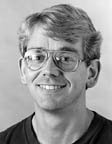
Profile
Bill Martin
|
Bill Martin is part of a WHOI Sea Grant-supported team of investigators sampling harbor and bay sediments to answer those questions. Martin, along with his WHOI colleagues Roger Francois and graduate student Linda Kalnejais, joined forces with a USGS Woods Hole Marine Field Center investigation led by Mike Bothner. That partnership brought considerable baseline information to the project.
"Mike has data from the late-1970s through the early-1990s showing that heavy metal concentrations in the harbor sediments have been decreasing, and our recent data show that the trend continues," says Martin. "The question we're asking is whether the decrease is due simply to dilution of polluted sediments by clean inputs, or rather, to transfer of the metals to other locations."
Sediment cores taken from a harbor site (Hull Bay) and a Massachusetts Bay site (just west of the outfall) provide samples that can be analyzed in solid phase and from which sediment pore waters can be extracted. Both analysis methods, says Martin, will lead to a better understanding of sediment cycling and factors controlling heavy metal cycling.
Of course it's never as easy as it sounds. Getting data from the samples requires
detailed and time-consuming analyses, undertaken by Kalenjais, a fifth year MIT-WHOI
Joint Program in Chemical Oceanography student. In the study's first phase, investigators
focused on the exchange of dissolved metals between the sediments and seawater.
To quantify this exchange, they measure the concentrations of heavy metals dissolved
in the sedimentary pore waters and in samples from in situ benthic flux chambers.
The benthic flux chambers incubate sediments on the seafloor, allowing for direct
estimates of the transport of dissolved metals from sediments to the overlying
water.
"Now we are looking at metal cycling within the sediments, which appears to result in a concentrated layer of metals in the solid phase, near the sediment surface," explains Martin. "If that is the case," he says, "metals could be re-suspended by bottom currents and transported elsewhere."
The 2004 sampling program will expand to include a third fine-grained sediment
site, this one in Cape Cod Bay. Because of storm wind and sediment transport
patterns, Cape Cod Bay may accumulate metals that have been remobilized from
the Boston Harbor site, says Martin. "What we find out will help us project
the effects of anthropogenic metal release in the region and interpret future
monitoring data," he says. "And that information should be applicable to other
urban coastal areas--a key goal of our Sea Grant project." |
Return to Top
 Long
before 1988, when presidential candidate George Bush declared it "the
filthiest harbor in America," the sediments and water quality of Boston
Harbor had been scrutinized. Today, nearly four years after the region's
sewage discharge was diverted from the harbor to a site nine miles
offshore in Massachusetts Bay, scientists are studying the harbor
with new questions: what do the sediments near the original discharge
site look like today? Have things improved? And what about sediments
near the new outfall discharge?
Long
before 1988, when presidential candidate George Bush declared it "the
filthiest harbor in America," the sediments and water quality of Boston
Harbor had been scrutinized. Today, nearly four years after the region's
sewage discharge was diverted from the harbor to a site nine miles
offshore in Massachusetts Bay, scientists are studying the harbor
with new questions: what do the sediments near the original discharge
site look like today? Have things improved? And what about sediments
near the new outfall discharge?